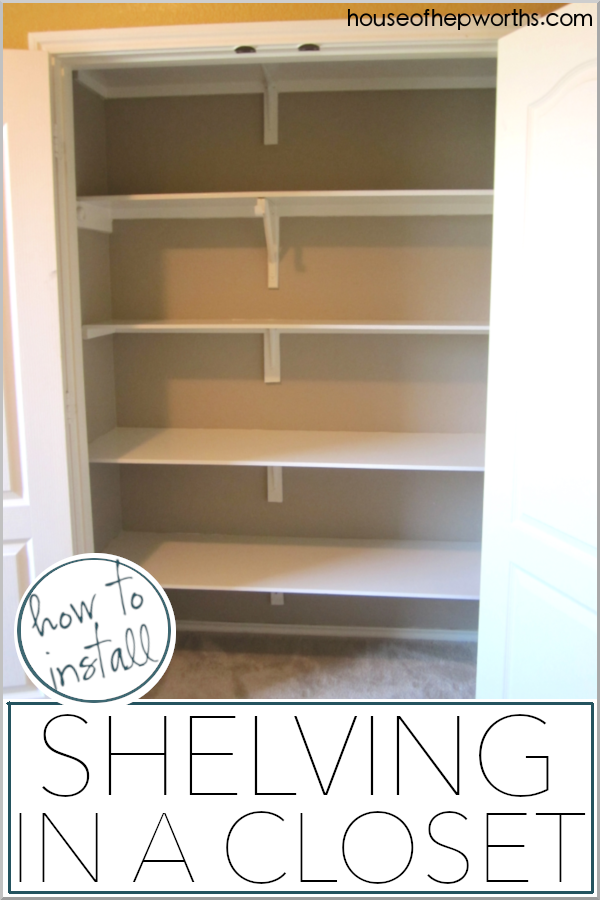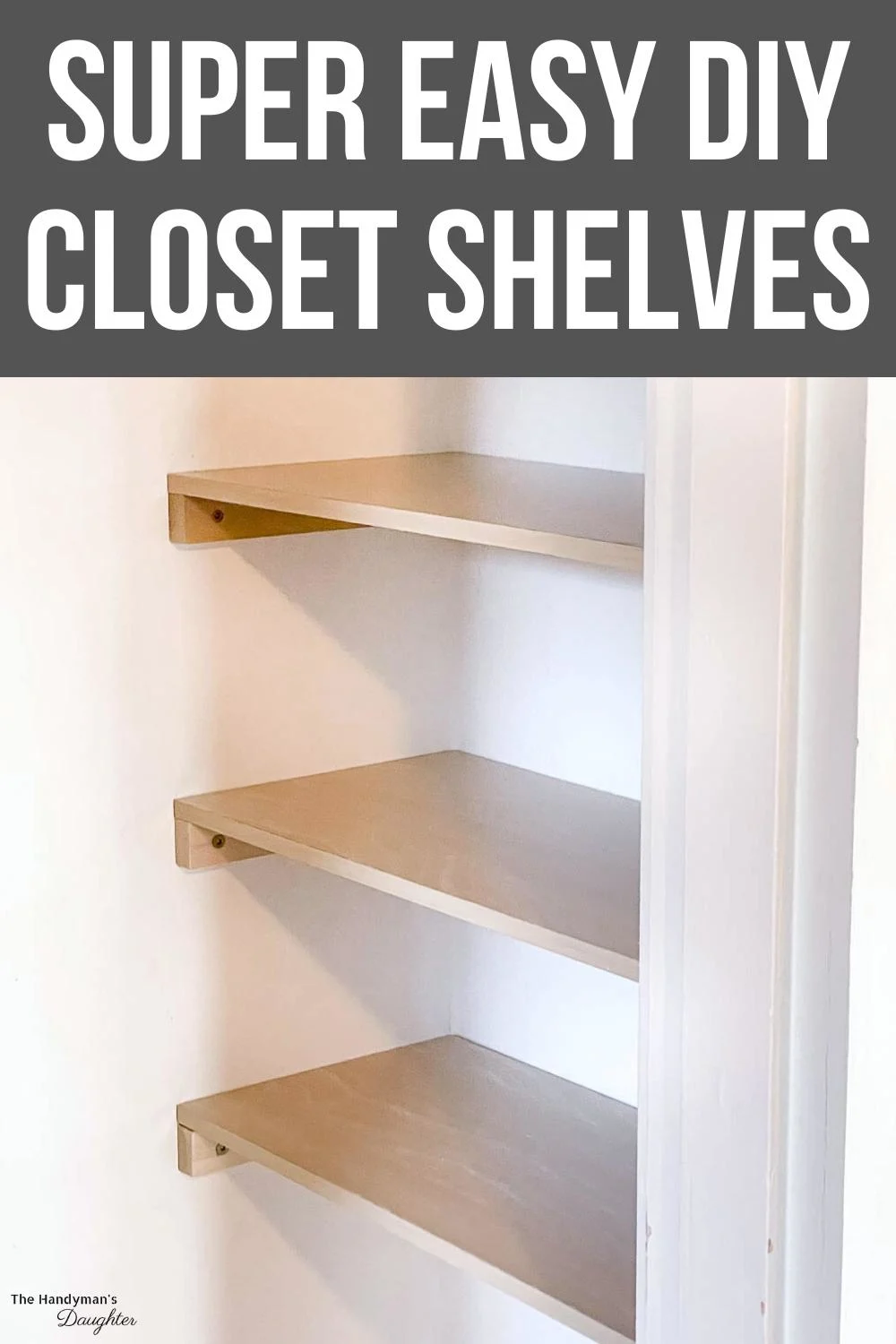To put up closet shelves, first measure the shelf and mark the wall for installation. Use a level to ensure the shelves are straight.
Then, drill pilot holes, insert wall anchors if needed, and secure the shelf brackets. Finally, place the shelf onto the brackets and secure it with screws. Closet shelves can help you maximize storage space and keep your belongings organized. Whether it’s for clothes, shoes, or accessories, adding shelves to your closet can make a significant difference in keeping things tidy and easily accessible.
In this guide, we’ll walk you through the steps on how to put up closet shelves and ensure that they are secure and functional. With the right tools and a little know-how, you can transform your closet into an efficient and well-organized space. Let’s get started!

Credit: m.youtube.com
Choosing The Right Materials
When putting up closet shelves, selecting the right materials is crucial for a sturdy and functional result.
Type Of Shelving
Determine the type of shelving based on your storage needs and the aesthetic you want to achieve.
Measurement And Sizing
Ensure accurate measurement and sizing of the shelves to fit the available space in your closet.
Support Brackets
Choose sturdy support brackets that can bear the weight of the items you plan to store on the shelves.
Preparing The Closet
In order to successfully put up closet shelves, the first step is preparing the closet. This involves clearing out the closet, cleaning and patching any imperfections, and finding studs to ensure the shelves are properly supported.
Clearing Out The Closet
- Take out all items from the closet to create space.
- Sort through the belongings to decide what to keep and what to discard.
- Store items temporarily in boxes to make room for shelf installation.
Cleaning And Patching
- Thoroughly clean the closet to remove dust and debris.
- Inspect the walls for any holes or damages that need to be patched.
- Use spackling compound to fill in any holes and sand down for a smooth surface.
Finding Studs
Locating the studs in the closet wall is crucial for securely anchoring the shelves.
Measuring And Marking
When it comes to organizing your closet, installing shelves is a crucial step. Closet shelves not only provide additional storage space but also help keep your clothes and other belongings neat and easily accessible. To begin the process of putting up closet shelves, you need to master the art of measuring and marking. This involves determining the desired shelf height, marking the wall accurately, and measuring the shelf length precisely. Let’s dive into these steps in detail:
Determining Shelf Height
Before you start drilling holes and installing brackets, it’s essential to determine the ideal height for your closet shelves. This may vary based on the items you plan to store on the shelves. For example, if you primarily intend to store folded clothes, a standard shelf height of around 12-16 inches should work well. However, if you have hanging items like dresses or coats, you’ll need to consider leaving enough space beneath the shelf for them to hang freely. Bear in mind that it’s always a good idea to leave a few inches of extra space above and below the shelf for easy maneuverability.
Marking The Wall
Accurate markings are key to ensuring your closet shelves are level and properly aligned. Once you’ve determined the desired shelf height, use a measuring tape or a level to mark the appropriate spots on the wall where the brackets will be installed. Start by measuring and marking the height of the first shelf, making sure to account for any baseboard or trim. Use a pencil to draw a level line across the entire width of the wall where the shelf will be positioned. Repeat this process for additional shelves, making sure to maintain uniformity in terms of both height and alignment.
Measuring Shelf Length
Now that you have your wall markings in place, it’s time to measure the length of the shelves. Begin by measuring the width of your closet space, taking into account any obstructions such as door frames or corners. Next, decide on the desired depth of your shelves. A depth of around 12-16 inches is usually sufficient for most folded items. Using these measurements, calculate the length of your shelves, allowing for additional length to cover the space occupied by brackets or supports. Make sure to double-check your measurements before cutting the shelves to avoid any unnecessary hassle later on.
In conclusion, taking careful measurements and marking the wall accurately are crucial steps when putting up closet shelves. By determining the appropriate shelf height, marking the wall precisely, and measuring the shelf length accurately, you’ll be well on your way to creating a well-organized and functional closet space. So grab your measuring tape, level, and pencil, and let’s get those shelves installed!
Credit: thediyplaybook.com
Installing Support Brackets
When it comes to putting up closet shelves, installing support brackets is a crucial step to ensure sturdy and reliable shelving. The support brackets provide the foundation for the shelves, so it’s essential to pay attention to detail during the installation process. This guide will walk you through the steps of locating bracket placement and securing brackets to the wall.
Locating Bracket Placement
Before you start drilling holes in your wall, make sure you have a solid plan for where the support brackets will be placed. Using a tape measure and level, mark the exact positioning for each bracket. Ensure they are evenly spaced and aligned to support the weight of your shelves. Double-check your measurements before moving on to the next step.
Securing Brackets To The Wall
Once you have determined the placement of the support brackets, it’s time to secure them to the wall. Using a drill and appropriate screws, carefully attach the brackets to the wall, making sure they are level and firmly secured. It’s important to use anchors if you are drilling into drywall to ensure the brackets can support the weight of the shelves without pulling away from the wall.
Attaching Closet Shelves
When putting up closet shelves, start by measuring the space and selecting the appropriate shelving material. Use a level to ensure the shelves are straight and secure. Then, attach the brackets and shelves according to the instructions provided, creating a functional and organized storage solution.
Cutting Shelving Material
Cut the shelving material to the required size using a power saw or a handsaw. Measure and mark the size accurately for precise cutting.
Positioning And Leveling
Use a level to ensure that the brackets are positioned correctly and are level. This step is crucial to guarantee the stability and balance of the closet shelves.
Attaching Shelves To Brackets
Align the shelves with the brackets and secure them in place using screws or nails. Make sure they are attached firmly to support the weight of items placed on the shelves.

Credit: www.houseofhepworths.com
Adding Finishing Touches
Once you have successfully installed your closet shelves, it’s time to add those final finishing touches that will make your closet look polished and organized. This last step includes filling holes and sanding, painting or staining, as well as securing any loose shelves. Let’s dive into each of these tasks to achieve a professional-looking closet space.
Filling Holes And Sanding
Before you move on to the next step, take a moment to inspect your newly installed closet shelves for any visible holes or gaps. To ensure a seamless finish, grab a small container of wood filler that matches the color of your shelves. Fill each hole or gap with the wood filler, using a putty knife to spread it evenly. Allow the filler to dry completely, and then gently sand the area using medium-grit sandpaper. Sanding will create a smooth surface and prepare the shelves for the next step.
Painting Or Staining
If you want to add a pop of color or enhance the natural beauty of the wood, painting or staining your closet shelves is a great option. First, decide which method you prefer and gather the necessary supplies such as paint, brushes, or wood stain. Before applying any paint or stain, make sure to clean the shelves thoroughly to remove any dust or debris. If you choose to paint, apply a thin coat of primer to ensure better adhesion. Then, with steady brush strokes, apply the paint evenly. If staining, use a clean cloth or brush to apply the stain following the wood’s grain. Allow the shelves to dry completely before handling them again.
Securing Loose Shelves
If you discover any shelves that feel a bit wobbly or unstable, it’s important to secure them properly. Use a level to ensure the shelves are aligned correctly and adjust them if necessary. Once the shelves are in the desired position, attach brackets or screws to hold them securely in place. This will provide stability and prevent any accidents in the future. Take a few moments to double-check that all the shelves are secure before organizing your belongings.
Organizing And Styling
Organizing and styling your closet shelves is essential for maintaining a neat and functional space. By arranging shelf items, using closet organizers, and adding decorative elements, you can create a visually appealing and organized closet.
Arranging Shelf Items
Group similar items together to make it easier to find what you need.
- Arrange clothes by type (e.g., tops, pants, dresses).
- Stack folded items neatly to maximize shelf space.
- Use baskets or bins to store smaller items like accessories.
Using Closet Organizers
Invest in closet organizers to keep your shelves tidy and clutter-free.
- Install shelf dividers to separate different items.
- Utilize hanging organizers for shoes or bags.
- Consider drawer organizers for socks or undergarments.
Adding Decorative Elements
Enhance the look of your closet shelves with decorative touches.
- Use decorative storage boxes to conceal clutter.
- Add plants or artwork to bring life to your space.
- Incorporate stylish trays or jars for a cohesive look.
Tips And Tricks
Using Leveling Tools
Ensure precision by utilizing a leveling tool to guarantee straight and well-aligned closet shelves.
Utilizing Corner Spaces
Maximize storage in your closet by utilizing often unused corner spaces to add shelves and increase organization.
Creating Adjustable Shelves
Incorporate adjustable shelves to allow for flexibility in the future as your storage needs may change.
Frequently Asked Questions On How To Put Up Closet Shelves
How Can I Determine The Best Location For Closet Shelves?
To determine the best location for closet shelves, consider the height of your clothes, the available space, and accessibility. Position shelves at a comfortable height for easy access to your items, ensuring they don’t interfere with hanging clothes.
What Materials Do I Need To Put Up Closet Shelves?
You will need shelving boards, brackets, a tape measure, a level, a pencil, a drill, screws, and anchors. It’s important to choose materials that can support the weight of the items you plan to store on the shelves.
What’s The Recommended Weight Capacity For Closet Shelves?
The weight capacity of your closet shelves depends on the materials used and how they are installed. Typically, shelves should be able to support at least 25-30 pounds per linear foot. However, heavier items or longer spans may require additional support.
How Can I Ensure My Closet Shelves Are Properly Installed?
To ensure proper installation of closet shelves, use a level to ensure they are straight and secure. It’s crucial to follow the manufacturer’s guidelines for the chosen materials and hardware, ensuring the shelves can safely support the intended items.
Conclusion
Installing closet shelves can greatly increase your storage space and help you stay organized. By carefully following these steps and taking the necessary precautions, you can confidently put up your own closet shelves without any professional assistance. Remember to measure accurately, use quality materials, and secure the shelves properly for long-lasting durability.
With a little patience and effort, your closet will become a functional and clutter-free space. So get started and enjoy the benefits of a well-organized wardrobe!
{ “@context”: “https://schema.org”, “@type”: “FAQPage”, “mainEntity”: [ { “@type”: “Question”, “name”: “How can I determine the best location for closet shelves?”, “acceptedAnswer”: { “@type”: “Answer”, “text”: “To determine the best location for closet shelves, consider the height of your clothes, the available space, and accessibility. Position shelves at a comfortable height for easy access to your items, ensuring they don’t interfere with hanging clothes.” } } , { “@type”: “Question”, “name”: “What materials do I need to put up closet shelves?”, “acceptedAnswer”: { “@type”: “Answer”, “text”: “You will need shelving boards, brackets, a tape measure, a level, a pencil, a drill, screws, and anchors. It’s important to choose materials that can support the weight of the items you plan to store on the shelves.” } } , { “@type”: “Question”, “name”: “What’s the recommended weight capacity for closet shelves?”, “acceptedAnswer”: { “@type”: “Answer”, “text”: “The weight capacity of your closet shelves depends on the materials used and how they are installed. Typically, shelves should be able to support at least 25-30 pounds per linear foot. However, heavier items or longer spans may require additional support.” } } , { “@type”: “Question”, “name”: “How can I ensure my closet shelves are properly installed?”, “acceptedAnswer”: { “@type”: “Answer”, “text”: “To ensure proper installation of closet shelves, use a level to ensure they are straight and secure. It’s crucial to follow the manufacturer’s guidelines for the chosen materials and hardware, ensuring the shelves can safely support the intended items.” } } ] }
